Bb4.1
Presumably the last glyph in line Bb3 coincided with November 27
(331, *251) when Aldebaran (*68, 148) - in principle - should be at
the Full Moon. 148 + 183 = 331. *251 - *183 = *68.
And in May 28 (148 = 331 - 183) Itzam-Yeh
(Ursa Major) had been defeated, given that we are using the Gregorian
calendar also for the year 3149 BC.
|
Itzam-Yeh defeated |
28 May (148 = 225 - 77), 3149 BC |
|
1st 3-stone place |
21 May (141 = 225 - 84), 3114 BC |
|
Creation of our present world |
13 August (225), 3114 BC |
|
Och ta chan (Hun-Nal-Ye 'entered or
became the sky') |
5 February (36 = 141 - 105), 3112 BC |
|
21 May,
3114 BC - 5 February, 3112 BC = 224 + 282 + 36 = 506 +
36 = 542
542 'happens to be' the sum of 365 days
and 6 * 29½ nights. |
A quick calculation will indicate the precessional depth down from
my assumed era of rongorongo (AD 1842) to 3149 BC is slightly
more than *70 days, and *68 + *70 =
*138 = *320 (Dramasa)
- *182.
(1842 + 3149) / 26000 * 365.2425 =
*70.1125 and *68.2 + *70.1 = *138.
The Sun would in the Golden Age of the Bull have been at the
right ascension line for the South Pole star (Dramasa)
in DECEMBER 2 (336) when the Full Moon would have
been in JUNE 1 (152 = 336 - 184) at κ Ursae Majoris,
where the right front paw was uplifted:

|
Egyptian hand |
 |
Phoenician
kaph |
 |
Greek
kappa |
Κ (κ) |
|
Kaph is thought to have been
derived from a pictogram of a hand (in both modern
Arabic and modern Hebrew, kaph means
palm/grip) ...
... The manik,
with the tzab, or serpent's rattles as
prefix, runs across Madrid tz. 22 , the figures in
the pictures all holding the rattle; it runs across
the hunting scenes of Madrid tz. 61, 62, and finally
appears in all four clauses of tz. 175, the
so-called 'baptism' tzolkin. It seems impossible,
with all this, to avoid assigning the value of
grasping or receiving. But in the final
confirmation, we have the direct evidence of the
signs for East and West. For the East we have the
glyph Ahau-Kin, the Lord Sun, the Lord of
Day; for the West we have Manik-Kin, exactly
corresponding to the term Chikin, the biting
or eating of the Sun, seizing it in the mouth.



The pictures (from Gates) show east,
north, west, and south; respectively (the lower two
glyphs) 'Lord' (Ahau) and 'grasp' (Manik).
Manik was the 7th day sign of the 20 and
Ahau the last ... |

This was 77 days before August 13 (225) and a week after May 21
(141).
We should therefore search for the First 3-stone Place at glyph
number 542 - 7 = 535:
 |
 |
|
Bb3-33
(111 = 2 * 266 - 421) |
Bb3-34
(13 * 41 = 542 - 9 = 168 + 365) |
|
mai tae tu |
ki te hipu |
|
Hipu. Calabash,
shell, cup, jug, goblet, pot, plate, vase,
bowl, any such receptacle; hipu hiva,
melon, bottle; hipu takatore,
vessel; hipu unuvai, drinking glass.
P Mgv.: ipu, calabash, gourd for
carrying liquids. Mq.: ipu, all sorts
of small vases, shell, bowl, receptacle,
coconut shell. Ta.: ipu, calabash,
cup, receptacle. Churchill.
 |
|
Nov 17 |
18 (322) |
|
Iklīl al Jabhah-15
(Crown of the Forehead) /
Anuradha-17 (Following
Rādhā) /
Room-4 (Hare)
ξ
Lupi,
λ
Cor. Bor.(241.1),
ZHENG =
γ
Serpentis,
θ
Librae (241.2),
VRISCHIKA =
π
Scorpii
(241.3),
ε
Cor.
Borealis (241.5),
DSCHUBBA
(Front of Forehead) = δ Scorpii
(241.7), η Lupi (241.9) |
υ
Herculis (242.3),
ρ
Cor. Borealis (242.4),
ι
Cor. Borealis (242.5),
θ
Draconis (242.6),
ξ
Scorpii (242.7)
SCHEDIR (Breast) α Cassiopeiae
*201.0 = *242.4 - *41.4 |
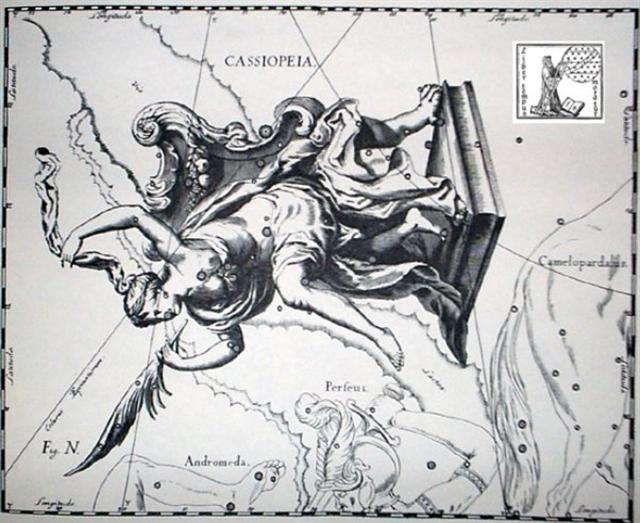 |
|
RIGHT
ASCENSION LINES AT THE FULL MOON: |
|
ZAURAK (Boat) = γ Eridani
(58.9) |
λ Tauri (59.3), ν Tauri (59.9) |
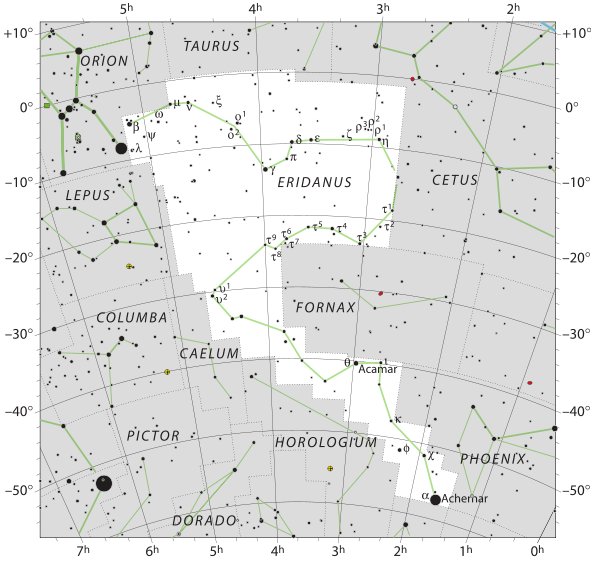 |
 |
 |
 |
|
Bb3-35 (534) |
Bb3-36 → 4 *
84 = 56 + 280 |
Bb3-37 (115 =
460 / 4) |
|
gutu huri - e toa maro |
kua vero
hia raua - ki to
maro |
|
Nov 19 |
20 |
21 (325 = 321
+ 4) |
|
16h (243.5)
ACRAB (Scorpion) = β Scorpii,
JABHAT AL ACRAB (Forehead of the Scorpion) = ω
Scorpii
(243.3), θ Lupi,
RUTILICUS = β Herculis
(243.5),
MARFIK (Elbow) = κ Herculis
(243.7), φ Herculis (243.8) |
ψ
Scorpii (244.6),
LESATH (Sting) =
ν
Scorpii
(244.8) |
χ
Scorpii (245.1),
YED PRIOR (Hand in Front) =
δ
Ophiuchi,
δ
Tr.
Austr. (245.5) |
 |
|
RIGHT
ASCENSION LINES AT THE FULL MOON: |
|
4h (60.9)
JĪSHUĬ = λ Persei
(60.7)
COR CAROLI (α Canum Ven.) |
υ Persei
(61.2) |
BEID (Egg) =
ο¹
Eridani
(62.2),
μ
Persei (62.8)
VINDEMIATRIX ( ε Virginis) |
|
Egyptian sky pillar |
 |
Phoenician waw |
 |
Greek
upsilon |
Υ (υ) |
|
... Upsilon
(uppercase Υ, lowercase υ; Greek:
ύψιλον, żpsilon ... is the 20th
letter of the Greek alphabet. In the
system of Greek numerals, Υ has a
value of 400. It is derived from the
Phoenician waw ... Waw (wāw
'hook') is the sixth letter of the
Semitic abjads ...
... Upsilon is known as
Pythagoras' letter, or the Samian
letter, because Pythagoras used it
as an emblem of the path of virtue
or vice. As the Roman writer Persius
wrote in Satire III:
and the letter
which spreads out into Pythagorean
branches has pointed out to you the
steep path which rises on the right.
Lactantius, an early Christian
author (ca. 240 - ca. 320), refers
to this:
For they say that
the course of human life resembles
the letter Y, because every one of
men, when he has reached the
threshold of early youth, and has
arrived at the place 'where the way
divides itself into two parts', is
in doubt, and hesitates, and does
not know to which side he should
rather turn himself“...
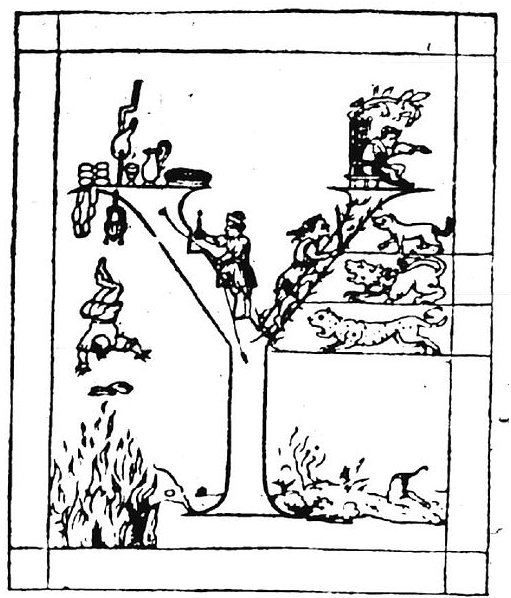 |
|
Possibly the arrangement of these 3 'stones' (for
cooking vessels) were alluded to in Bb3-38:
.jpg)
And the outline of the constellation Cassiopeia may have influenced its
basic design (resembling
Σ with the Man at left and the Woman in
front):
 |
 |
 |
|
Bb3-38 (537 =
542 - 5) |
Bb3-39 |
Bb3-40 (118 =
4 * 29½) |
|
ma to kava - kua huri te hatu |
ki te henua |
ma te maitaki |
|
... In Hindu
legend there was a mother goddess called
Aditi, who had seven offspring. She is
called 'Mother of the Gods'. Aditi, whose
name means 'free, unbounded, infinity' was
assigned in the ancient lists of constellations
as the regent of the asterism Punarvasu.
Punarvasu is dual in form and means 'The
Doublegood Pair'. The singular form of this noun
is used to refer to the star Pollux. It is not
difficult to surmise that the other member of
the Doublegood Pair was Castor. Then the
constellation Punarvasu is quite
equivalent to our Gemini, the Twins. In far
antiquity (5800 BC) the spring equinoctial point
was predicted by the heliacal rising of the
Twins ...
Maitaki.
Clean, neat, pure, pretty, nice, beautiful,
handsome; tagata rima maitaki,
clean-handed man, correct man. Vanaga. 1. Good.
Henua maitaki = the good earth. 2. Shine.
Marama maitaki = the shining moon.
Barthel. Ce qui est bon. Jaussen according to
Barthel. Meitaki, good, agreeable,
efficacious, excellent, elegant, pious, valid,
brilliant, security, to please, to approve (maitaki);
ariga meitaki, handsome, of pleasant
mien; mea meitaki ka rava, to deserve;
meitaki ke, marvelous, better.
Hakameitaki, to make good, to amend, to do
good, to bless, to establish. Meitakihaga,
goodness. PS Pau.: maitaki, good. Mgv.:
meitetaki, beautiful, good. Mq.:
meitai, good, agreeable, fit, wise,
virtuous. Ta.: maitaiki, good, well.
Niuē: mitaki, good. Maitakia,
clean. Churchill. |
|
Nov 22 |
23 (327) |
24 |
|
YED POSTERIOR (Hand Behind) =
ε
Ophiuchi,
RUKBALGETHI SHEMALI (Northern Knee of the Giant)
=
τ
Herculis
(246.6).
δ
Apodis (246.7),
ο
Scorpii (246.8) |
Heart-5 (Fox)
σ
Scorpii
(247.0),
HEJIAN =
γ
Herculis
(247.2),
ψ
Ophiuchi (247.7) |
ρ
Ophiuchi (248.1),
KAJAM (Club) =
ω
Herculis
(248.3),
χ
Ophiuchi (248.5),
SHE LOW (Market Tower) =
υ
Ophiuchi,
Tr.
Austr. (248.7), ζ Tr. Austr. (248.8) |
 |
|
RIGHT
ASCENSION LINES AT THE FULL MOON: |
|
Al Dabarān-2 (The
Follower)
HYADUM I =
γ
Tauri (63.4)
*22.0 = *63.4 - *41.4 |
HYADUM II = δ¹ Tauri
(64.2) |
Net-19 (Crow)
AIN (Eye) =
ε
Tauri,
θ¹
Tauri,
θ²
Tauri (65.7) |
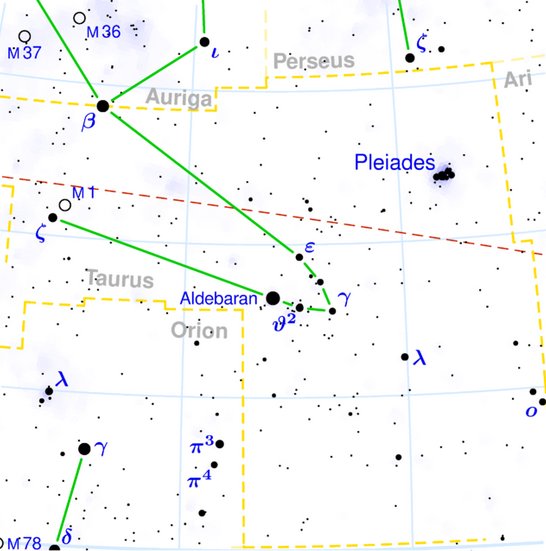 |
|
... There was no water in the
village. The lakes and rivers were dry. Raven
and Crow, two young girls who were having their
first menstrual courses, were told to go and
draw water from the ocean. Finding the journey
too long, Raven decided just to urinate into her
basket-bucket. She decieved no one and was
severly scolded. Crow returned much later but
with drinking water. As a punishment, Raven was
condemned never to find water in the summer;
only in winter would she find something to
drink. For that reason the Raven never drinks
during the hot months; she speaks with a raucous
voice because of her dry throat ... |
 |
 |
 |
|
Bb3-41 (540 = 3 * 180) |
Bb3-42
(541 - 421 = 120) |
Bb3-43
(542 = 177 + 365) |
|
mai tae vere
hia - ki te
pito o te henua |
e nuku hoi |
kua here te toa - i ruga
o to maro |
|
Vere.
1. Beard, moustache (vede G);
vere gutu, moustache; verevere,
shaggy, hairy, tow, oakum. Mgv.: veri,
bristly, shaggy, chafed (of a cord long in
use). Mq.: veevee, tentacles. Ta.:
verevere, eyelash. 2. To weed (ka-veri-mai,
pick, cut-grass T); verevere, to
weed. P Mgv.: vere, to weed. Mq.:
veéveé, vavee, id. 3. Verega,
fruitful, valuable; verega kore,
unfruitful, valueless, contemptible, vain,
futile, frivolous; tae verega,
insignificant, valueless; mataku verega
kore, scruple. Mgv.: verega, a
design put into execution; one who is apte,
useful, having a knowledge how to do things.
4. Ta.: verevere, pudenda muliebria.
Ma.: werewere, id. (labia minora).
Churchill. Sa.: apungaleveleve,
apongaleveleve, a spider, a web. To.:
kaleveleve, a large spider. Fu.:
kaleveleve, a spider, a web. Niuē:
kaleveleve,
a cobweb. Nukuoro: halaneveneve,
a spider. Uvea: kaleveleve,
a spider. Mgv.: pungaverevere,
a spider. Pau.: pungaverevere,
cloth. Mg.: pungaverevere,
a cobweb. Ta.: puaverevere,
id. Mao.: pungawerewere,
puawerewere,
puwerewere,
a spider. Ha.: punawelewele,
a spider, a web. Mq.: pukaveevee,
punaveevee,
id. Vi.: lawa,
a fishing net; viritālawalawa,
a cobweb; butalawalawa,
a spider. Churchill 2.
Pito.
1. Umbilical cord; navel; centre of
something: te pito o te henua, centre
of the world. Ana poreko te poki, ina ekó
rivariva mo uru ki roto ki te hare o here'u
i te poki; e-nanagi te pito o te poki, ai
ka-rivariva mo uru ki roto ki te hare,
when a child is born one must not enter the
house immediately, for fear of injuring the
child (that is, by breaking the taboo on a
house where birth takes place); only after
the umbilical cord has been severed can one
enter the house. 2. Also something used for
doing one's buttons up (buttonhole?).
Vanaga. Navel. Churchill. H Piko 1.
Navel, navel string, umbilical cord. Fig.
blood relative, genitals. Cfr piko pau
'iole, wai'olu. Mō ka piko,
moku ka piko, wehe i ka piko, the navel
cord is cut [friendship between related
persons is broken; a relative is cast out of
a family]. Pehea kō piko? How is your
navel [a facetious greeting avoided by some
because of the double meaning]? 2. Summit or
top of a hill or mountain; crest; crown of
the head; crown of the hat made on a frame (pāpale
pahu); tip of the ear; end of a rope;
border of a land; center, as of a fishpond
wall or kōnane board; place where a
stem is attached to the leaf, as of taro. 3.
Short for alopiko. I ka piko nō
'oe, lihaliha (song), at the belly
portion itself, so very choice and fat. 4. A
common taro with many varieties, all with
the leaf blade indented at the base up to
the piko, junction of blade and stem.
5. Design in plaiting the hat called
pāpale 'ie. 6. Bottom round of a
carrying net, kōkō. 7. Small wauke
rootlets from an old plant. 8. Thatch above
a door. 'Oki i ka piko, to cut this
thatch; fig. to dedicate a house. Wehewehe. |
|
Nov 25 → 9 * 25 = 225 |
26 (330) |
27 |
|
Al Kalb-16 (The Heart)
/
Jyeshtha-18 (Eldest)
/
ANA-MUA-1 (Entrance
pillar)
ANTARES = α Scorpii
(249.1),
MARFIK (Elbow) = λ Ophiuchi,
φ Ophiuchi (249.5), ω Ophiuchi (249.8) |
γ Apodis (250.1), σ Herculis (250.3), θ Tr.
Austr. (250.6),
τ Scorpii
(250.7) |
HAN = ζ Ophiuchi
(251.0) |
|
... In China, with
Capricornus, Pisces, and a part of
Sagittarius, it [Aquarius] constituted the
early Serpent, or Turtle, Tien Yuen;
and later was known as Hiuen Ying,
the Dark Warrior and Hero, or Darkly
Flourishing One, the Hiuen Wu, or
Hiuen Heaou, of
the Han dynasty, which Dupuis gave as
Hiven Mao. It was a symbol of the
emperor Tchoun Hin, in whose reign
was a great deluge; but after the Jesuits
came in it became Paou Ping, the
Precious Vase. It contained three of the
sieu, and headed the list of zodiac signs as
the Rat, which in the far East was
the ideograph for 'water', and still so
remains in the almanacs of Central Asia,
Cochin China, and Japan ...

|
|
Egyptian sticks |
 |
Phoenician
taw |
 |
Greek chi |
Χ (χ) |
|
Greek tau |
Τ (τ) |
|
In Plato's
Timaeus, it is explained
that the two bands that form the
soul of the world cross each
other like the letter Χ.

Roman XII = 12 → XIII = 13, with
the Nose in between - and later,
after the Mouth, the cycle would
begin anew (I).
Chi or X is
often used to abbreviate the
name Christ, as in the holiday
Christmas (Xmas). When fused
within a single typespace with
the Greek letter Rho, it is
called the labarum and used to
represent the person of Jesus
Christ. (Wikipedia)

... tau
is the 19th letter of the Greek
alphabet. In the system of Greek
numerals it has a value of 300
... Taw is believed to be
derived from the Egyptian
hieroglyph meaning 'mark' ...
Taw,
Tav or Taf is the
twenty-second and last letter in
many Semitic abjads ... In
gematria Tav represents
the number 400, the largest
single number that can be
represented without using the
Sophit forms ...
'From Aleph
to Taf' describes
something from beginning to end;
the Hebrew equivalent of the
English 'From A to Z' ...
Tav is
the last letter of the Hebrew
word emet, which means
truth. The midrash explains that
emet is made up of the
first, middle, and last letters
of the Hebrew alphabet (Aleph,
Mem, and Tav...).
Sheqer (falsehood), on
the other hand, is made up of
the 19th, 20th, and 21st (and
penultimate) letters.
Thus, truth is
all-encompassing, while
falsehood is narrow and
deceiving. In Jewish mythology
it was the word emet that
was carved into the head of the
Golem which ultimately
gave it life. But when the
letter 'aleph' was erased from
the Golem's forehead,
what was left was 'met' -
dead. And so the Golem
died ... (Wikipedia)

|
|
|
RIGHT
ASCENSION LINES AT THE FULL MOON: |
|
No star listed (66) |
No star listed (67) |
Rohini-4 (The Red One)
/
Pidnu-sha-Shame-4
(Furrow of Heaven)
/
ANA-MURI-2 (Rear pillar - at the foot of
which was the place for tattooing)
ALDEBARAN = α Tauri
(68.2),
THEEMIN = υ² Eridani
(68.5) |
|
May 26 |
27 (80 +
67 = 147) |
28 (148 =
225 - 77) |
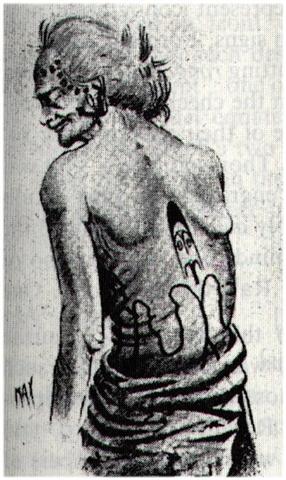 |
As a kind of proof I will offer the resemblance between glyph
number 542 and the Pithagorean letter:
Epimenides stated
that all Cretans lied, which was an example of curved
(unbounded, infinite) logic, because he himself was a
Cretan. This was the opposite of the straightforward linear
logic at the other side of the coin - the kind we in the
industrialized western culture have entangled ouselves in.
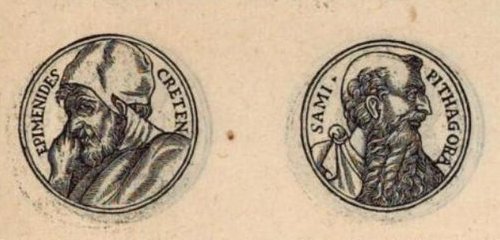
|












.jpg)









